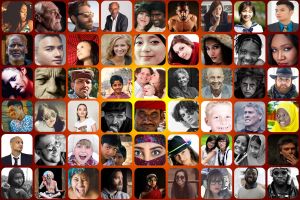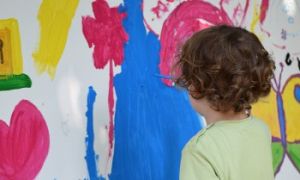Aboriginal and Torres Strait Islander people cultures are valued and significant in Australia and it's essential for educators to help children understand the history, culture and lives of the Aboriginal and Torres Strait Islander community.
"Aboriginal Education is not only appropriate education of Aboriginal students but also must involve the education of ALL children about Indigenous Australia" - (Aboriginal Education Policy, NSW, AEGG Inc, 1995).
The NQS emphasises the importance of early childhood services forming partnerships with Aboriginal and Torres Strait Islander communities. For non-indigenous educators, we are often scared about "getting it wrong" or being "tokenistic" in programming, but the most important thing is to make a start and then keep going. It's important to engage with the culture - have a personal connection and going through the proper avenues to gain an understanding of the culture and build relationships with Aboriginal and Torres Strait Islander communities. If using a national event such as NAIDOC week, it's a good opportunity to start learning, then it provides a good foundation to keep going forward.
It's important that we educate ourselves to feel confident in passing on knowledge about Aboriginal and Torres Strait Islander cultures to all children in a meaningful and informed way. As educators it's vital we increase our knowledge of Aboriginal Australia from past to present which will assist us to create accessible and inclusive environments.
Supporting Educators Learn About Aboriginal Australia
To promote access and inclusion within the service and assist educators to develop their knowledge and understanding of Aboriginal Australia the following strategies may help:
- Attend relevant training
- Meet and talk with Aboriginal people outside of the service
- Consult with local Lands Council, Aboriginal cultural centres etc.
- Access resources from organisations such as Indigenous professional Support Unit (IPSU), the Secretariat of National Aboriginal and Islander Child Care (SNAICC) etc.
- Gain an Aboriginal perspective of different matters by reading widely outside of mainstream media.
- Watch Indigenous television programs such as National Indigenous Television Network (NITV).
- Listen to Indigenous radio programs.
- Learn about your local community's Indigenous history and heritage.
Including Aboriginal Australia Within The Service
It's recommended to create a whole service plan for inclusion that involves all educators and families. The plan needs to incorporate objectives and strategies and support all children within the service to have a better understanding and connection with Aboriginal Australia.
The following are strategies that your service can use to begin and acknowledge Aboriginal Australia.
- Acknowledge Of Country at all meetings and important events, including meetings with children.
- For events with significant meaning, consult with local Elders groups or land councils about a Welcome to Country.
- Create a calendar of indigenous events that can be celebrated at the service. Add local events that are happening within the Indigenous community to the parent and staff notice board.
- Invite indigenous performers and artists into the service and hold workshops for children and families.
- Network with the local Aboriginal community and partner with them on a specific project.
- Invite Elders from your local community to take part in celebrations and significant events.
- Name an area in your service in a local language, Consult with local Aboriginal Lands Council in regards to protocol and use of language in your local community.
- Set up a "sister service" in-country or remote areas. Stay in contact through internet or exchange postcards or mail.
- Plant a tree in your service to acknowledge a significant date on the Indigenous calendar.
Learning Opportunities and Experiences
Two important considerations to keep in mind when including Aboriginal and Torres Strait Islander perspectives in the curriculum, are (i) avoiding stereotypes and (ii) ensuring that content is truly embedded, rather than singled out as special or ‘different’.
There are many ways to embed Aboriginal and Torres Strait Islander perspectives into the curriculum, including through:
- Block Play - with small Australian animals, deserts and billabongs, linking with storytelling and music and movement.
- Cooking and Food-related Experiences: using indigenous and/or native ingredients, finding and tasting‘bushtucker’ in collaboration with local AboriginalandTorresStrait Islander person.
- Dolls and Props - having dolls with a range of skin colours and features, and using traditional baby carriers (coolamons) and other culturally relevant items.
- Family Histories - talking with children about where they come from, who they are connected to, who the members of their families are. Using questions such as these along with maps can assist in showing family connections to other countries and places. Part of this exploration can be about Aboriginal and Torres Strait Islander people’s connections to their Land and their Country, tribal groups and Nations.
- Games - traditional Aboriginal and Torres Strait Islander games or games involving Australian animals.
- Language - using words in local Aboriginal languages for greetings, finding out the aboriginal names of Australian animals, plants, body parts and other terms children understand. Be sure that you use a reliable source of information for these words, for example, the local cooperative or local families. As you would do with all children, ask Aboriginal and Torres Strait Islander children’s families about words they commonly use at home so that you could include them at your ECEC service or school, and so that you have a better understanding of the words the children might use.
- Movement Experiences - learning some traditional and contemporary Aboriginal dance movements, for example, those that are based on Australian animals, and creating new movements.
- Music Experiences - listening and responding to traditional and contemporary Aboriginal and Torres Strait Islander music or making and using clapping sticks. Remember that traditionally only males are allowed to play or even handle didgeridoos.
- Nature-related Experiences - planting trees or other plants indigenous to your area using advice from an Aboriginal Elder or Leader from the local cooperative or exploring indigenous plants in the area; gathering natural materials such as pods, leaves, bark, flowers and seeds and sorting and classifying them.
- Puzzles - sourcing and using puzzles that have diverse images of Aboriginal and Torres Strait Islander cultures, people and animals.
- Resources - puzzles, books, musical instruments, recorded music, DVDs, posters and images of contemporary Aboriginal and Torres Strait Islander people, dolls, artwork, flags, maps and fabric with traditional and contemporary patterns. It is important to source these resources where possible from Aboriginal and TorresStrait Islanderagenciesororganisations to ensure that they are authentic.
- Seasons - learning about the seasons as described and understood by Aboriginal and Torres Strait Islander people.
- Significant Anniversaries and Celebrations - including significant days/weeks for Aboriginal and Torres Strait Islander people in your service’s calendar of events.
- Storytelling, Reading and Using Picture Books - including Creation Stories and oral storytelling.
- Visitors - inviting Aboriginal and Torres Strait Islander dancers, musicians or storytellers or those in the community with other talents and interests to share these with the children. It is critically important to involve AboriginalandTorresStraitIslanderpeopleinways that go beyond sharing a traditional culture. It is important for children and families to learn about the various ways that AboriginalandTorresStraitIslanderpeoplecontributeto the community.
- Visual Arts Experiences: using natural materials such as ochre and nature colours for painting and drawing; discussingAboriginalandTorresStraitIslanderartby different artists and identifying styles, symbols and stories
To implement genuine inclusive environments than a meaningful understanding of acknowledgement and understanding of Aboriginal and Torres Strait Islander communities is essential.
As educators, we play an important role in helping children to create a positive perspective, understanding and appreciation for Australia Aboriginal and Torres Stit Islander history, culture and lives.
References:
- Bamford M & Maguire, K. (2012) - Including Aboriginal Australia In Your Service. Sydney
- NQS - Professional Learning Program (2013) - Aboriginal and Torres Strait Islander Cultures In ECE. - Early Childhood Australia







 As an Educator in Australia, your pay rate falls under the Children’s Services Award 2010. This award states the minimum amount that an employer can
As an Educator in Australia, your pay rate falls under the Children’s Services Award 2010. This award states the minimum amount that an employer can When working as a qualified Early Childhood Teacher (with a university degree) within a service, your rate of pay will come from the Educational Services
When working as a qualified Early Childhood Teacher (with a university degree) within a service, your rate of pay will come from the Educational Services When working as a Diploma Qualified Educator your pay rate is from the Children's Services Award 2010. This Award states your minimum rate of pay
When working as a Diploma Qualified Educator your pay rate is from the Children's Services Award 2010. This Award states your minimum rate of pay When working as a Cert 3 Qualified Educator, your pay rate is from the Children's Services Award 2010. This Award states your minimum rate of
When working as a Cert 3 Qualified Educator, your pay rate is from the Children's Services Award 2010. This Award states your minimum rate of Educational Leaders play a crucial role in their early childhood service by ensuring that the educational program aligns with best practices and supports the holistic
Educational Leaders play a crucial role in their early childhood service by ensuring that the educational program aligns with best practices and supports the holistic In early childhood education and care, ratios are more than a technicality—they are a frontline safeguard. Every child deserves responsive supervision, emotional connection, and developmental
In early childhood education and care, ratios are more than a technicality—they are a frontline safeguard. Every child deserves responsive supervision, emotional connection, and developmental With the new national child safety reforms kicking in on 1 September 2025, early childhood services like yours have a real opportunity to lead the
With the new national child safety reforms kicking in on 1 September 2025, early childhood services like yours have a real opportunity to lead the Here’s a comprehensive Mobile Phone and Smart Watch Policy tailored for early childhood education and care (ECEC) services in Australia, aligned with the latest 2025
Here’s a comprehensive Mobile Phone and Smart Watch Policy tailored for early childhood education and care (ECEC) services in Australia, aligned with the latest 2025 The Sea of Fish Challenge is a national initiative that invites children, educators, families, and communities to create and display fish artworks as a symbol
The Sea of Fish Challenge is a national initiative that invites children, educators, families, and communities to create and display fish artworks as a symbol Cold weather play is incredibly beneficial for early childhood development! It helps children build resilience, strengthen their immune systems, and develop essential motor skills. Here’s
Cold weather play is incredibly beneficial for early childhood development! It helps children build resilience, strengthen their immune systems, and develop essential motor skills. Here’s


